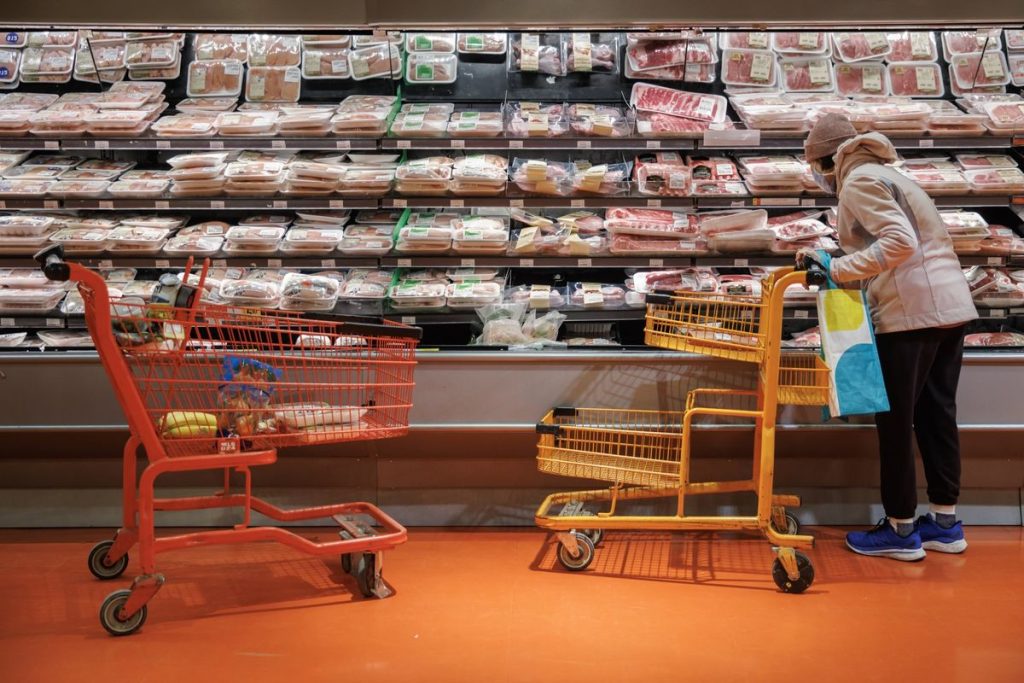
Canadian inflation pressures eased in January, leaving the Bank of Canada some room to hold interest rates at current levels next month even after a blockbuster jobs report.
The consumer price index rose 5.9% from a year ago, Statistics Canada reported Tuesday in Ottawa, slower than the 6.1% gain expected in a survey of economists and down from 6.3% in December. On a monthly basis, the index rose 0.5% in January, versus expectations of 0.7%.
Bonds rallied, pushing the benchmark two-year yield down to 4.163% at 8:54 a.m., about 7 basis points lower than its trading level prior to the data release. The Canadian dollar dropped.
Two key yearly measures tracked closely by the central bank — the so-called trim and median core rates — edged lower, averaging 5.05% from an upwardly revised 5.25% a month earlier. Economists were also expecting a reading of 5.05%.
“The Canadian data is showing clearly — surprisingly — a more disinflationary trend at the beginning of this year, and for sure that will comfort the Bank of Canada going into the March decision,” Dominique Lapointe, director of macro strategy at Manulife Investment Management, said.
Inflation in services eased to 5.3% from 5.6% in December.
The data suggest that 425 basis points of interest-rate hikes in 11 months are starting to temper price gains, though inflation remains well above the Bank of Canada’s 2% target. The figures also support views that inflation will continue to ease this year, allowing the central bank to hold rates steady at 4.5% at its next decision on March 8.
Governor Tiff Macklem explicitly declared a conditional pause last month, saying policymakers would move to the sidelines and assess the impact of their rapid tightening on the economy. Macklem said he expects growth in output to be near zero in the first three quarters of this year, which will allow the economy to move from excess demand to modest excess supply and “relieve inflationary pressures.”
He forecasts the headline rate of price pressures to fall to 3% by midyear, and return to 2% target by 2024.
The inflation report came less than two weeks after jobs data showed employment grew by 150,000 positions, a 10-fold surge past expectations, while the jobless rate held steady at 5%. It was the fifth straight month of increases for a labor market that continues to defy all predictions of a coming slowdown this year.
Still, the central bank is likely to keep off the hiking path if price pressures continue to ease. Policymakers said the bar for raising rates is now much higher and that they would need to see an “accumulation of evidence” that price pressures and the economy aren’t cooling fast enough to consider another hike.
Before Tuesday’s report, swaps traders were fully pricing in another 25 basis-point hike by July, which would bring the benchmark overnight rate to 4.75%.
While headline inflation in January grew at a slower pace in part due to a base-year effect, prices for cellular services and passenger cars contributed to the deceleration.
Higher prices for gasoline, meat and interest costs are among the biggest contributors to price gains last month.
In January, gasoline prices rose 2.9% year-over-year, food prices were up 10.4%, and the mortgage interest cost index jumped 21.2% — the largest increase since September 1982. Rent gained 5.8%.
“Today’s data added to evidence that inflation is coming under control, even as growth in the economy continues to hold up better than expected in the face of higher interest rates, creating a confusing picture for the Bank of Canada,” Andrew Grantham, an economist at Canadian Imperial Bank of Commerce, said in a note.
Retail Sales
With inflation showing signs of cooling, Canadian consumers kept on spending despite higher interest rates weighing on indebted households.
An advance estimate suggested receipts for retailers jumped 0.7% in January, following a 0.5% increase in December, which was led by higher sales of motor vehicles and parts, the statistics agency said in another release on Tuesday.
The growth in December adds to a flat reading in November and a 1.3% gain in October, ending last year with relatively strong retail sales.
The data also show consumers remained resilient at the start of 2023 as a tight labor market — with unemployment near a record low and strong wage gains — has allowed many Canadians to keep buying goods and services.
Both the median estimate in a survey of economists and the statistics agency’s own estimate called for a 0.5% rise in December sales. Excluding auto and parts, retail sales fell 0.6%, and in volume terms, retail sales grew 1.3%.
The agency didn’t give details for the January number. But a similar development south of the border may provide some signals. Last month, US retail sales rose by the most in nearly two years, led by motor vehicles, furniture and restaurants.